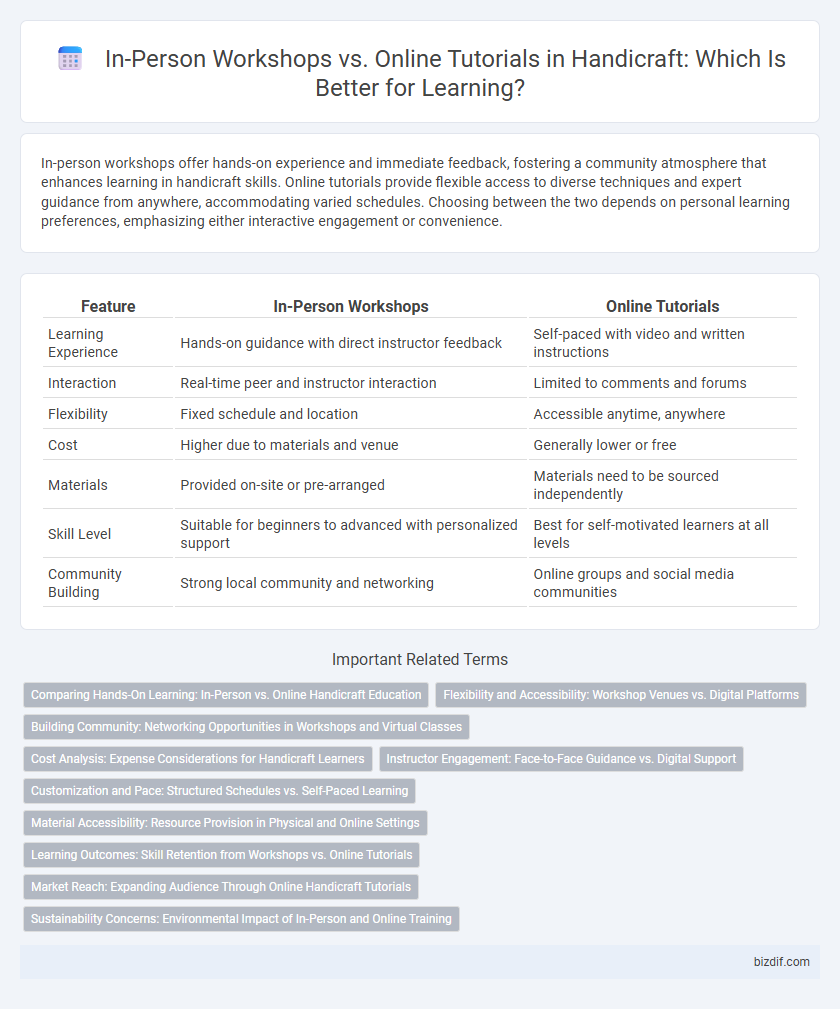In-person workshops offer hands-on experience and immediate feedback, fostering a community atmosphere that enhances learning in handicraft skills. Online tutorials provide flexible access to diverse techniques and expert guidance from anywhere, accommodating varied schedules. Choosing between the two depends on personal learning preferences, emphasizing either interactive engagement or convenience.
Table of Comparison
| Feature | In-Person Workshops | Online Tutorials |
|---|---|---|
| Learning Experience | Hands-on guidance with direct instructor feedback | Self-paced with video and written instructions |
| Interaction | Real-time peer and instructor interaction | Limited to comments and forums |
| Flexibility | Fixed schedule and location | Accessible anytime, anywhere |
| Cost | Higher due to materials and venue | Generally lower or free |
| Materials | Provided on-site or pre-arranged | Materials need to be sourced independently |
| Skill Level | Suitable for beginners to advanced with personalized support | Best for self-motivated learners at all levels |
| Community Building | Strong local community and networking | Online groups and social media communities |
Comparing Hands-On Learning: In-Person vs. Online Handicraft Education
In-person workshops offer tactile engagement and real-time feedback essential for mastering intricate handicraft techniques, fostering a more immersive learning environment. Online tutorials provide flexibility and access to diverse skill levels but often lack immediate personalized guidance, which can hinder skill refinement. Comparing hands-on learning, the physical presence in workshops significantly enhances dexterity development and collaborative creativity, crucial elements in handicraft education.
Flexibility and Accessibility: Workshop Venues vs. Digital Platforms
In-person workshops offer tactile learning experiences but are limited by fixed venue locations and schedules, which can restrict participant availability. Online tutorials provide unparalleled flexibility, allowing learners to access materials anytime from any location with internet connectivity. Digital platforms expand accessibility, accommodating diverse skill levels and enabling self-paced progress without geographical constraints.
Building Community: Networking Opportunities in Workshops and Virtual Classes
In-person handicraft workshops foster stronger community connections by enabling direct interaction, collaboration, and immediate feedback among participants, which enhances networking opportunities. Online tutorials provide access to a broader audience, allowing crafters worldwide to share ideas and resources through virtual forums and social media groups. Both platforms contribute uniquely to building a supportive handicraft community, with workshops emphasizing personal engagement and online classes offering scalable communication channels.
Cost Analysis: Expense Considerations for Handicraft Learners
In-person workshops often incur higher costs due to venue fees, material expenses, and travel, making them less accessible for budget-conscious handicraft learners. Online tutorials provide a cost-effective alternative with lower overheads, often requiring only an internet connection and basic supplies. Evaluating these expenses helps learners choose a format that aligns with their financial constraints while gaining quality craftsmanship skills.
Instructor Engagement: Face-to-Face Guidance vs. Digital Support
In-person workshops offer direct instructor engagement, providing immediate feedback and hands-on guidance that enhances skill development in handicraft techniques. Online tutorials deliver flexible, accessible digital support but often lack the personalized interaction crucial for mastering intricate craft details. The choice between these formats impacts the depth of learning and the effectiveness of instructor-student communication in crafting skills.
Customization and Pace: Structured Schedules vs. Self-Paced Learning
In-person handicraft workshops offer personalized guidance and immediate feedback, allowing participants to customize projects and adjust techniques in real-time. Structured schedules foster consistent progress but may limit flexibility for varied learning speeds or individual creative exploration. Online tutorials provide self-paced learning, enabling artisans to revisit instructions and tailor the crafting process to their unique style and timing.
Material Accessibility: Resource Provision in Physical and Online Settings
In-person handicraft workshops provide immediate access to diverse materials and tools, allowing participants to physically explore textures and techniques onsite. Online tutorials often rely on participants sourcing their own materials, which can vary in availability depending on geographic location and budget constraints. Resource provision in physical settings tends to offer a more comprehensive hands-on experience, while online formats require detailed supply lists and sometimes curated kits to bridge the material accessibility gap.
Learning Outcomes: Skill Retention from Workshops vs. Online Tutorials
In-person handicraft workshops enhance skill retention through hands-on practice and immediate instructor feedback, fostering deeper understanding and fine motor skill development. Online tutorials offer flexibility and repeated access, but often lack interactive guidance, which can limit mastery and long-term retention. Studies show that tactile engagement and real-time correction significantly improve the durability of learning outcomes in crafting skills.
Market Reach: Expanding Audience Through Online Handicraft Tutorials
Online handicraft tutorials significantly expand market reach by enabling artisans to connect with a global audience beyond geographical limitations. These digital platforms facilitate interactive learning experiences that attract diverse demographics, increasing potential customer bases and brand visibility. In-person workshops offer personalized guidance but are limited by local attendance, making online tutorials essential for scaling handicraft business growth.
Sustainability Concerns: Environmental Impact of In-Person and Online Training
In-person workshops for handicrafts often generate more environmental waste through materials used and travel emissions, contributing to a larger carbon footprint compared to online tutorials. Online tutorials reduce the need for physical resources and eliminate travel, lowering overall energy consumption and greenhouse gas emissions. Choosing online training supports sustainability by minimizing environmental impact while still providing accessible skill development.
In-person workshops vs Online tutorials Infographic

 bizdif.com
bizdif.com